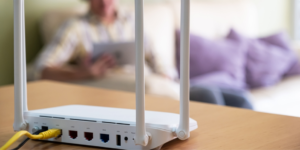Introduction
In today’s digital age, a strong and stable Wi-Fi connection is essential for our daily lives. Whether you’re working from home, streaming your favorite shows, or simply browsing the internet, a reliable Wi-Fi signal is crucial. One of the key factors that can significantly impact your Wi-Fi’s performance is the placement of your router. In this article, we will explore where to place your Wi-Fi router to ensure you get the most out of your network.
In our increasingly connected world, a poor Wi-Fi signal can lead to frustration and decreased productivity. To get the most out of your Wi-Fi network, it’s crucial to place your router strategically. Let’s dive into the details of optimal router placement and how it can significantly enhance your internet experience.
Understanding Wi-Fi Signals
Before we delve into router placement, it’s essential to understand how Wi-Fi signals work. Wi-Fi signals operate on radio frequencies and can be affected by various factors, including interference from other electronic devices, physical obstacles, and signal degradation over distance.
Factors Affecting Wi-Fi Signal Strength

Having a reliable Wi-Fi connection is essential in our modern world, but several factors can impact the strength and quality of your Wi-Fi signal. Understanding these factors is crucial for optimizing your network performance. Here are the key elements that can affect Wi-Fi signal strength:
Distance from the Router
One of the most significant factors influencing Wi-Fi signal strength is the distance between your device and the router. The farther you are from the router, the weaker the signal becomes. This phenomenon is known as signal attenuation.
Obstacles in the Signal Path
Physical obstacles like walls, floors, ceilings, and large furniture can obstruct the Wi-Fi signal. Thick walls and structures with metal components can be particularly problematic as they absorb and reflect radio waves, reducing signal strength.
Interference from Other Devices
Wi-Fi operates on specific radio frequencies, and other electronic devices can operate on similar frequencies, causing interference. Common culprits include microwave ovens, cordless phones, Bluetooth devices, and even neighboring Wi-Fi networks. This interference can lead to signal drops and slower speeds.
Router Quality and Type
The type and quality of your router play a significant role in signal strength. High-end routers with multiple antennas and advanced technology generally provide better coverage and performance compared to basic models.
Channel Congestion
Wi-Fi routers broadcast signals on specific channels, and when multiple routers in the vicinity use the same channel, it can lead to congestion and reduced signal quality. Selecting a less crowded channel can alleviate this issue.
Signal Interference from Neighbors
If you live in a densely populated area, neighboring Wi-Fi networks can overlap with yours, causing signal interference. This is more likely to occur in apartment buildings or crowded neighborhoods.
Router Positioning
The physical placement of your router within your home or office can greatly affect signal strength. Routers placed on the floor or inside cabinets tend to have weaker signals than those elevated and centrally located.
Antenna Direction and Placement
The orientation of your router’s antennas also matters. Omni-directional antennas emit signals in all directions, while directional antennas focus signals in specific directions. The way you position these antennas can impact signal coverage.
Weather Conditions
Extreme weather conditions, such as heavy rain or snow, can weaken Wi-Fi signals, especially if the signal has to pass through walls or windows to reach your device.
Interference from Household Appliances
Some household appliances, like refrigerators, can emit electromagnetic interference that disrupts Wi-Fi signals. It’s essential to be aware of the placement of such devices concerning your router.
Understanding these factors and taking steps to mitigate their effects can significantly improve your Wi-Fi signal strength and overall network performance. By optimizing your router placement, minimizing interference, and choosing the right equipment, you can enjoy a faster and more reliable Wi-Fi connection for all your online activities.
| Call 866-861-4084 for Internet Deals |
Choosing the Right Router
Selecting the right router is a crucial step in ensuring a robust and reliable Wi-Fi network tailored to your needs. The router serves as the gateway between your devices and the internet, so making an informed decision is essential. Here are key considerations to keep in mind when choosing the right router:
Internet Speed and Bandwidth Requirements
Start by understanding your internet plan’s speed and bandwidth requirements. Different routers offer varying speeds and capabilities, so matching your router’s capabilities to your internet plan is essential. If you have a high-speed connection, consider a router that supports gigabit speeds.
Router Type
There are different types of routers available, including single-band, dual-band, and tri-band routers. Single-band routers operate on the 2.4GHz frequency and are suitable for basic internet usage. Dual-band routers offer both 2.4GHz and 5GHz bands, providing better performance and less interference. Tri-band routers have an additional 5GHz band, ideal for households with many devices.

Coverage Area
Consider the size of the area you need to cover with Wi-Fi. Larger homes or offices may require routers with stronger signals and broader coverage. Look for routers with high-gain antennas or mesh Wi-Fi systems that can extend coverage seamlessly.
Number of Connected Devices
Think about how many devices will be connected to your network simultaneously. Gaming consoles, smartphones, tablets, smart TVs, and IoT devices all contribute to network congestion. Ensure your router can handle the expected device load without slowing down.
Quality of Service (QoS) Support
QoS allows you to prioritize certain types of traffic, such as video streaming or online gaming, over others. A router with QoS capabilities can help optimize your network for specific applications, ensuring a smoother user experience.
Security Features
Security is paramount. Look for routers that offer robust security features, including WPA3 encryption, firewall protection, and the ability to create guest networks. Regular firmware updates are also essential for addressing security vulnerabilities.
Router Brand and Reputation
Established router brands often provide better reliability and customer support. Research the reputation of the router manufacturer and read user reviews to gauge the reliability of the product.
Ease of Setup and Management
A user-friendly interface and straightforward setup process can save you a lot of frustration. Some routers come with mobile apps that make network management easy, allowing you to monitor and control your network from your smartphone.
Price and Budget
Routers come in a wide price range, so it’s essential to set a budget beforehand. While it’s tempting to opt for the cheapest option, investing a bit more in a higher-quality router can pay off in terms of performance and longevity.
Future-Proofing
Technology evolves rapidly. Consider whether the router you’re eyeing supports future technologies like Wi-Fi 6 (802.11ax) or Wi-Fi 6E, which offer improved speed, capacity, and efficiency.
Warranty and Support
Check the warranty and support options offered by the router manufacturer. A longer warranty period and responsive customer support can provide peace of mind.
Compatibility
Ensure that the router is compatible with your internet service provider’s infrastructure. Some ISPs have specific requirements or recommendations for compatible routers.
By carefully evaluating these factors, you can make an informed decision when choosing the right router for your specific needs. Investing in a router that aligns with your requirements not only enhances your Wi-Fi experience but also ensures a stable and secure connection for all your connected devices.
Ideal Router Placement
The placement of your Wi-Fi router is a critical factor that directly impacts the performance and coverage of your wireless network. A well-placed router ensures that your devices receive a strong and reliable Wi-Fi signal, leading to a smoother online experience. Here are key considerations for achieving ideal router placement:
Central Location
Positioning your router in a central location within your home or office is paramount. This central placement helps distribute the Wi-Fi signal more evenly, ensuring that all areas receive adequate coverage. When the router is centrally located, it reduces the chances of signal dead zones in remote corners of your space.

Elevation Matters
Routers should be elevated to improve signal propagation. Placing the router on a higher surface, such as a shelf, cabinet, or wall mount, allows the Wi-Fi signal to travel more effectively. This elevation minimizes the signal’s interaction with obstacles like furniture, walls, and other electronics that can obstruct its path.
Avoid Physical Obstructions
Clear line-of-sight between the router and your devices is essential for optimal signal strength. Physical obstructions, such as walls, floors, ceilings, and large pieces of furniture, can attenuate the Wi-Fi signal. To improve signal quality, position the router in a way that minimizes the number of obstructions between it and your devices.
Mind Interference
Electronic devices that emit electromagnetic interference can disrupt Wi-Fi signals. Keep your router away from appliances like microwave ovens, cordless phones, baby monitors, and even older fluorescent lighting fixtures. These devices can operate on frequencies that interfere with Wi-Fi signals, causing drops in performance.
Signal Direction
Consider the direction in which your router emits its signal. Most consumer routers have omni-directional antennas, which radiate Wi-Fi signals in all directions. Ensure that these antennas are positioned vertically for optimal coverage. If your router has adjustable antennas, experiment with their angles to fine-tune signal distribution.
Adaptive Antenna Technology
Some modern routers come equipped with adaptive antenna technology that can adjust their signal strength and direction based on the connected devices’ locations. These routers can be particularly effective in maintaining strong connections throughout your space.
Wi-Fi Extenders or Mesh Systems
For large homes or offices with challenging layouts, Wi-Fi extenders or mesh systems can be invaluable. These devices can be strategically placed throughout your space to extend coverage and eliminate dead zones. Mesh systems, in particular, create a seamless network with a single SSID, ensuring a smooth transition between access points.

Consider Future Expansion
When positioning your router, think about the potential for future expansion or changes in your living or working environment. Being flexible with your router placement can make it easier to adapt to new needs or accommodate additional devices.
In conclusion, ideal router placement is a critical factor in optimizing your Wi-Fi network’s performance. By following these guidelines and considering the unique layout of your space, you can ensure that your router delivers a strong and reliable Wi-Fi signal to all your connected devices, enhancing your online experience.
If you want, you can also check out our extended blog on how to boost your Wi-Fi signal to get a better idea.
Tips for Specific Locations
Let’s explore some location-specific tips for router placement:
Home Office
Position your router near your home office setup to ensure a stable connection for remote work and video conferences.
Living Room
Place the router in the living room for seamless streaming and gaming experiences on your smart TV or gaming console.
Bedroom
For uninterrupted late-night browsing, consider positioning the router closer to your bedroom.
Kitchen
If you use Wi-Fi-enabled kitchen appliances, ensure your router reaches this area to control them effortlessly.
Basement
Extend your Wi-Fi network to the basement by placing the router strategically to cover this often overlooked space.
Securing Your Wi-Fi Network
Securing your Wi-Fi network is of paramount importance to safeguard your personal information, maintain network performance, and prevent unauthorized access. With the increasing number of devices connected to home networks, it’s crucial to implement robust security measures. Here are essential steps to secure your Wi-Fi network effectively:
1. Change Default Router Login Credentials
Most routers come with default usernames and passwords, which are often well-known and easily accessible to potential attackers. Change these default login credentials to strong, unique ones. This step is your first line of defense against unauthorized access to your router’s settings.
2. Enable WPA3 Encryption
Ensure that your Wi-Fi network uses WPA3 (Wi-Fi Protected Access 3) encryption, which is the latest and most secure encryption protocol available. This encryption method prevents eavesdropping and unauthorized access to your network. Avoid using older and less secure encryption methods like WEP (Wired Equivalent Privacy) or WPA2.
3. Set a Strong Wi-Fi Password
Choose a strong and complex Wi-Fi password that includes a combination of upper and lower-case letters, numbers, and special characters. Avoid using easily guessable information such as common phrases, birthdays, or names. The stronger your password, the harder it is for unauthorized users to crack it.

4. Enable Network Encryption
In addition to securing your Wi-Fi network, enable encryption for sensitive data transmission over the internet. Most websites and online services use HTTPS (HyperText Transfer Protocol Secure) to encrypt data. Ensure that your browser automatically connects to HTTPS websites to protect your information.
5. Create a Guest Network
If your router supports it, set up a separate guest network with a different password from your main network. This isolates your guests from your primary network, preventing them from accessing your shared files or sensitive information. Guest networks typically have limited privileges.
6. Use a Firewall
Enable the built-in firewall on your router to filter incoming and outgoing network traffic. Firewalls help block malicious traffic and protect your network from unauthorized access attempts.
7. Disable Remote Management
Most routers have a remote management feature that allows you to access router settings from outside your home network. It’s wise to disable this feature to prevent potential attackers from remotely altering your router’s settings.
8. Firmware Updates
Regularly check for firmware updates provided by your router manufacturer. These updates often include security patches that address vulnerabilities and enhance overall router performance. Keep your router’s firmware up to date to stay protected.
9. MAC Address Filtering
You can configure your router to allow only specific devices with known MAC addresses to connect to your network. While this adds an extra layer of security, it can be somewhat cumbersome to manage if you frequently add or remove devices from your network.
10. Monitor Network Activity
Keep an eye on your network activity using your router’s built-in tools or third-party applications. Monitoring network activity allows you to detect any suspicious or unauthorized access and take action promptly.

11. Regular Password Updates
Consider changing your Wi-Fi password periodically, especially if you suspect unauthorized access or if you’ve shared the password with guests. Changing the password ensures that even if someone had access before, they won’t have it anymore.
12. Educate Users
Educate everyone in your household or office about the importance of network security. Ensure they understand the significance of not sharing Wi-Fi passwords with unauthorized individuals and the potential risks of connecting to unsecured public networks.
Securing your Wi-Fi network is an ongoing process that requires diligence and attention to detail. By following these steps and staying informed about evolving security threats, you can create a secure environment for your internet-connected devices and maintain the confidentiality of your data.
| Call 866-861-4084 for Internet Deals |
Regular Maintenance
Maintaining your Wi-Fi network is essential to ensure consistent performance, security, and reliability. Just like any other system, your Wi-Fi network requires periodic attention to keep it running smoothly. Here’s a comprehensive guide to regular maintenance for your Wi-Fi network:
1. Update Firmware
Regularly check for firmware updates provided by your router’s manufacturer. Firmware updates often include critical security patches, bug fixes, and performance enhancements. Keeping your router’s firmware up to date is essential to address vulnerabilities and ensure optimal performance.
2. Clean and Ventilate Your Router
Dust and overheating can affect your router’s performance. Periodically, turn off the router, unplug it, and gently clean it using a soft, dry cloth. Ensure it has proper ventilation and is not obstructed by objects or placed in an enclosed space.
3. Monitor Network Activity
Use your router’s built-in tools or third-party applications to monitor network activity. Regularly review connected devices and look for any suspicious or unauthorized devices. Monitoring network activity helps you identify potential security breaches and ensures that only authorized devices are connected.
4. Review Security Settings
Periodically review and update your Wi-Fi network’s security settings. Ensure that you’re using the latest and most secure encryption protocol, such as WPA3. Double-check your Wi-Fi password’s strength and change it if necessary.

5. Optimize Channel and Bandwidth
Wi-Fi routers operate on specific channels within the 2.4GHz and 5GHz frequency bands. If you notice network congestion or interference, consider switching to a less crowded channel. Additionally, some routers offer bandwidth control settings, allowing you to prioritize certain devices or applications.
6. Check for Interference
Regularly inspect your environment for new sources of interference, such as electronic devices or changes in the placement of furniture and walls. Adjust the router’s position or antenna orientation to minimize interference.
7. Guest Network Management
If you have a guest network, periodically review its settings. Ensure that the guest network is secure and that guests have limited access to your primary network. Change the guest network password if needed, especially if it has been shared with multiple guests.
8. Evaluate Device Performance
Keep an eye on the performance of your devices connected to the Wi-Fi network. If you notice sluggish performance on specific devices, troubleshoot the issue. It might be a matter of updating the device’s network drivers or addressing signal strength issues.
9. Network Speed Tests
Conduct periodic network speed tests using online tools or dedicated apps. This helps you assess your internet connection’s actual speed and identify any performance issues. If you’re not getting the expected speed, contact your internet service provider for assistance.
10. Password Updates
Consider changing your Wi-Fi password regularly, especially if you’ve shared it with others or suspect unauthorized access. A periodic password change enhances security.
11. Backup Router Settings
Back up your router’s configuration settings periodically. This ensures that you have a copy of your custom settings in case of a router reset or replacement. Refer to your router’s user manual for instructions on how to create and restore backups.
12. Educate Users
Continuously educate all users in your household or office about the importance of responsible network usage and security practices. Encourage them to report any suspicious activity promptly. Regular maintenance ensures that your Wi-Fi network remains secure, efficient, and dependable. By following these steps and staying proactive, you can enjoy a stable and high-performing network for all your online activities.

Conclusion
Optimizing the placement of your Wi-Fi router can make a significant difference in the performance and reliability of your network. By following the guidelines outlined in this article, you can enjoy a faster, more stable, and hassle-free internet experience.
FAQs
How do I know if my router placement is optimal?
You can use Wi-Fi signal strength apps or conduct speed tests in different areas of your home to determine the best placement.
Can I place my router behind a TV or inside a cabinet?
It’s best to avoid such placements as they can block and weaken the Wi-Fi signal.
Should I always buy a router with directional antennas?
Not necessarily. The choice depends on your specific needs and the layout of your home.
What’s the importance of firmware updates for my router?
Firmware updates often include security patches and performance improvements, so keeping your router up to date is crucial.
How can I secure my Wi-Fi network effectively?
Use a strong, unique password, and enable the highest level of encryption (WPA3) supported by your router.

Jason ‘Jace’ Cooper is a digital maestro who’s journey in the dynamic realms of tech, internet, and gaming has been fueled by a passion for innovation. Crafting insightful narratives about the industry, Jace transforms complex topics into compelling tales that captivate and inform.